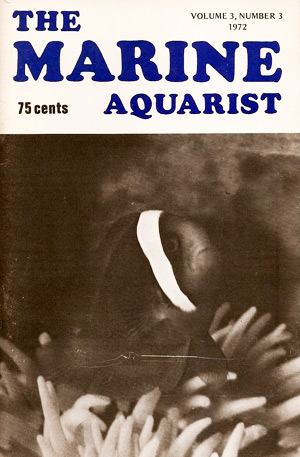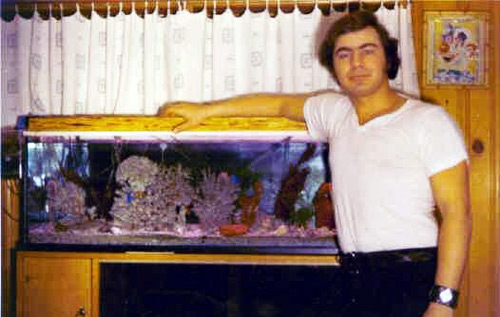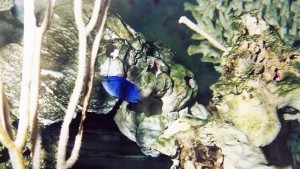Our hobby of keeping saltwater fish for the sole purpose of pleasure is not very old. People have been keeping fish for thousands of years, but virtually all of those fish were used as food. Asian cultures have been culturing carp and koi for enjoyment for centuries, but those are freshwater fish.
Roots in Merry Old England
Saltwater fish keeping for fun actually began in England about 200 years ago. At that time, wealthy Ladies had servants but lacked Oprah and soap operas, so they were bored and needed to find a hobby.
England’s damp climate is conducive to fern growth, so the ladies would traipse through the bogs with their long hoop skirts and corsets on looking for ferns. They would then put the ferns in tanks that had glass fronts and wooden or slate sides. Then they’d sketch pictures of their ferns and mail them to their friends. The rest of their time was spent trying to wash the mud out of their crinolines.
This went on for some time until all the ferns were collected and cataloged (and they ran out of clean clothes). So, some of the more adventurous ladies started to walk around in the shallow waters of bays and inlets looking for interesting creatures. Remember, there were no bikinis then, so they did this in long dresses.
From ferns to aquatic critters
To keep the critters they collected alive, the women had to have their fern tanks waterproofed. They went to shipbuilders for that, as they were the only people who could waterproof things. Home Depot was accessible only by time machine, so they could not get silicone. Tar was the preferred material to seal a tank with. Tank bottoms were made of slate because homes did not have central heating then, so whale oil lamps were placed under the tank to keep the water warm.
Just as they did with ferns, the ladies sketched and traded information on the aquatic critters they collected. They even learned that if they kept some seaweeds in the water with the animals, the creatures would live longer. I doubt they knew about photosynthesis, but they sure knew how to clean mud out of clothes!
Along comes WWII
Move ahead to WWII. When the war was over, people came home and started families. All the resultant kids needed a hobby, and fish started to become available. At the time, they were sold in toy stores as toy fish.
I, myself, had some of those fish in the early ‘50s. They came in a cardboard container like Chinese food comes in. Fish food was sold in cardboard boxes and consisted of dried ants. Of course, I collected earthworms. Until I discovered girls. I still collected worms after that, but I did it at night or when there were no girls around.
Saltwater fish hit the US

Saltwater fish were available in Germany in the late ‘60s, but not in the US. We got them here in 1970 or ‘71. The largest store in Manhattan, Aquarium Stock Company, which was a few blocks from the World Trade Center, got in some blue devils, and I bought seven of them. The colors on these fish just stood out because no one had seen captive saltwater fish before, and they were just awesome.
There was no information about saltwater fish, and most of us still had tanks with slate bottoms and steel corners. The only salt available that I remember was “Lambert Kay’s Marine Magic.” I didn’t have enough money for the fish and the salt, so I went down to the sea near the East River that runs past Manhattan and collected some water. Gravel was just for freshwater tanks, so I used driveway gravel. Lighting was incandescent bulbs in an aluminum or chrome housing. Powerheads were an airstone connected to a piston pump. The pump had a leather piston that had to be oiled, so oil got into the water. A few years later, true powerheads came out, but they were metal and were meant to be placed on top of UG filter tubes above the water.
There were no GFCI’s then, so we normally got shocked at least once a week. There were no sissies then, either, and the shocks kept us awake. You had to turn the light on with a stick because the salt creep from the airstones caused the metal light housing to become electrified. (And today people worry about a couple of volts of induced electricity!) Our “test kit” consisted of a metal thermometer. All filters were left over from the freshwater hobby and were HOB units with aluminum pumps. Inside the filters, we put that fiberglass filter floss, which later became nylon.
All fish had ich. I used to think that all saltwater fish just came with spots. We didn’t call it ich then. It was oodinium, then ich, then coral fish disease, then back to oodinium. Now I am not sure what it is called. The only medications available were either fluorescent-green stuff or fluorescent-blue stuff. Neither stuff actually cured anything, but it made the tank glow really cool colors. Sometimes I used to mix them to see if I could make a rainbow.
A penny for your thoughts
For the ich, we had to keep copper pennies in the tank, as liquid copper was not available. It was easy to tell if you had enough pennies in the tank: If the fish were living, you had enough pennies in the tank. If they were lying on the bottom gasping, you had to remove some pennies, maybe 13 cents or so—which was good because gas cost about 40 cents a gallon and I could get a quarter of a gallon of gas with the money I took out of my tank.
Anyway, that is how it began. Eventually more fish became available and inverts, such as arrow crabs and banded coral shrimp, became common. Then someone, maybe Al Gore, invented the internet and all the problems started.
One more thing: There were no corals available, but sometime in the ‘80s, I think, Germany banned the importation of angelfish to that country. Angelfish were a staple in a salt tank, so the hobbyists wanted something to fill the gap. Corals were the answer. And that is how coral keeping began.




